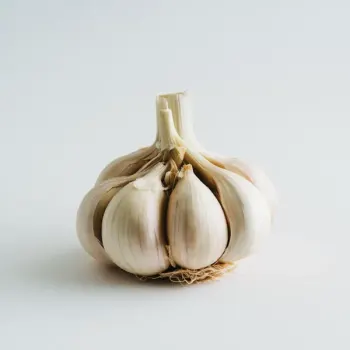Garlic and onions are culinary staples with distinct flavors; garlic is bold and pungent, while onions range from sweet to sharp. They enhance dishes differently—garlic adds a flavor punch, and onions build a savory base. Both are versatile and nutritious, offering unique benefits to a variety of recipes.

Garlic, known for its pungent aroma and bold flavor, is a member of the Allium family. It's used worldwide to infuse depth and character into a plethora of dishes.

Onions, also part of the Allium family, are a cornerstone of cooking, offering a range of flavors from sweet to sharp, depending on the variety and preparation.
Garlic and onions differ in taste; garlic has a strong, slightly spicy flavor that mellows with cooking, while onions offer a more complex taste profile, from sweet to astringent. Texturally, garlic is dense and can be minced into a paste, while onions are more fibrous and can provide a variety of cuts. Garlic bulbs are smaller and are typically used in smaller quantities, whereas onions can vary in size and are often used as a base ingredient in larger portions.

Your ultimate Recipe Box, Meal Planner, and Cooking Class all in one
In dishes like stir-fries or sautéed vegetables, garlic adds a quick punch of flavor. It's best added towards the end of cooking to prevent burning and to retain its potent taste. Onions form the foundation of sautéed dishes, sweating down to a translucent texture and developing sweetness. They're typically one of the first ingredients to hit the pan, creating a flavor base.
A few cloves of garlic can infuse soups and stews with a deep, aromatic essence. Use it sparingly to complement other flavors without overwhelming them. Onions are essential in building layers of flavor in soups and stews. They're often browned first to release their sugars and enrich the broth with a savory sweetness.
Whole or crushed garlic cloves roast beautifully alongside meats and vegetables, mellowing in flavor and becoming sweet and spreadable. Roasted onions caramelize and sweeten, contributing a complexity to roasted dishes. They can be cut into wedges or rings to ensure even cooking and caramelization.
Raw garlic is sharp and intense, perfect for adding a kick to dressings, marinades, and raw salsas. Crush or mince it finely to distribute its flavor evenly. Raw onions add crunch and a zesty sharpness to salads, sandwiches, and salsas. Soaking sliced onions in cold water can temper their bite if desired.
While both garlic and onions offer nutritional benefits such as vitamins and antioxidants, they are consumed in different quantities, which affects their overall contribution to your diet.
| Nutrient | Garlic ( per 100g ) | Onions ( per 100g ) |
|---|---|---|
| Fat | 0.5g | 0.1g |
| Fiber | 2.1g | 1.7g |
| Sodium | 17mg | 4mg |
| Protein | 6.4g | 1.1g |
| Calories | 149 | 40 |
| Carbohydrates | 33g | 9.3g |
Yes, onions can be used as a substitute for garlic to achieve a milder flavor, but they won't replicate garlic's unique pungency.
Garlic has a strong, spicy flavor that mellows with cooking, while onions have a broader spectrum of flavors, from sweet to sharp, depending on the type and preparation.
They are not directly interchangeable due to their flavor differences, but they can be substituted for each other with consideration of the impact on the dish's flavor.
For a milder flavor, onions are generally preferred as they are less pungent than garlic, especially when sweated or caramelized.
Both garlic and onions are associated with health benefits such as reducing the risk of certain diseases, thanks to their vitamins, minerals, and antioxidants.